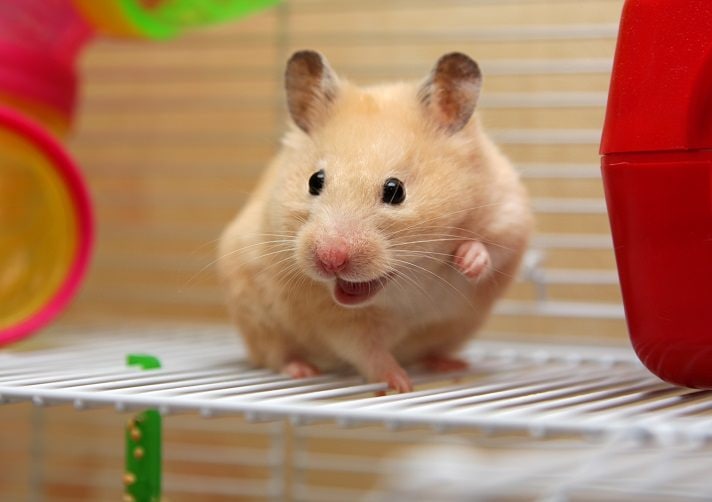Hamster Body Language You Need to Know
If you’ve ever wondered what a hamster is trying to say, you’re in the right place! In this article, we’re going to explore the fascinating world of hamster body language.
Have you ever noticed your hamster twitching their nose or flicking their tail? These are just a couple of the many ways hamsters communicate with us. Understanding their body language can help you bond with your furry friend and ensure their well-being.
So, grab a seat, get ready to decode some hamster signals, and let’s dive into the secret language of hamsters together!
Hamsters communicate through their body language, which can provide insights into their emotions and needs. Some common body language cues include flattened ears when scared, bristling fur when angry, and wagging tail when excited. Pay attention to their posture, facial expressions, and noises they make. By observing and understanding these signals, you can better meet your hamster’s needs and build a stronger bond. Remember, each hamster is unique, so take the time to learn their individual body language cues.

Understanding Hamster Body Language: Decoding the Silent Signals
Hamsters are adorable and fascinating creatures that communicate in their own unique way. While they may not speak our language, they have a sophisticated system of body language through which they express their emotions, thoughts, and needs. Understanding hamster body language can deepen the bond between you and your furry friend, allowing you to better meet their needs and ensure their well-being. In this article, we will explore the various aspects of hamster body language and learn how to interpret their silent signals.
1. Posture and Movements: Unveiling the Hamster’s State of Mind
Hamsters use their body posture and movements to communicate a range of emotions and intentions. Observing these subtle cues can provide valuable insights into their state of mind. For instance, a relaxed hamster will have a loose and floppy body posture, while a tense hamster may sit upright with a stiff body. Additionally, hamsters use certain gestures like stretching, grooming, and rolling around as an indicator of their contentment and comfort. Conversely, rapid and erratic movements may signal fear or distress. By paying attention to your hamster’s posture and movements, you can develop a deeper understanding of their emotions and respond accordingly.
2. Facial Expressions: Reading the Hamster’s Expressive Eyes and Ears
While hamsters may not have the same range of facial expressions as humans, they can still convey a wealth of emotions through their eyes and ears. Their eyes are particularly expressive, reflecting joy, curiosity, fear, or agitation. A calm and relaxed hamster will have bright, alert eyes, whereas a stressed hamster may have partially closed or darting eyes. Similarly, the position and movement of the ears can indicate their mood. Raised ears may signify alertness, while flattened ears may indicate fear or submission. By observing their facial expressions, you can gauge your hamster’s emotional state and provide the appropriate care and environment.
3. Vocalizations: Decrypting the Hamster’s Audio Communication
Although hamsters are generally quiet animals, they do utilize various vocalizations to communicate with their owners and fellow hamsters. Hamster vocalizations can include squeaks, chirps, hisses, and even purrs. These sounds serve different purposes, such as expressing happiness, seeking attention, asserting dominance, or warning of danger. For example, a high-pitched squeak can indicate excitement or pleasure, while a low growl may suggest aggression or fear. Paying attention to these vocal cues can help you understand what your hamster is trying to communicate and respond accordingly.
4. Scent Marking and Grooming: Aromatic Signals and Social Bonding
Hamsters have scent glands located on various parts of their bodies, and they use these glands to leave scent marks in their territories. Scent marking is an essential part of hamster communication, allowing them to establish ownership, mark boundaries, and signal reproductive readiness. By rubbing their bodies on objects or dragging their scent glands along surfaces, hamsters create a unique scent signature that is recognized by other hamsters. Additionally, grooming plays a vital role in hamster social bonding. Mutual grooming between hamsters strengthens their bond and maintains social harmony within a group.
5. Sleep and Wake Cycles: Understanding the Hamster’s Natural Rhythms
Hamsters are crepuscular animals, meaning they are most active during dawn and dusk. Understanding their sleep and wake cycles is essential for a harmonious relationship with your hamster. Hamsters typically sleep during the day, and any disturbances during this time may cause stress or aggression. It is crucial to provide a quiet and peaceful environment for your hamster during their sleep hours. At dusk and dawn, when they are most active, offer them stimulating activities and toys to keep them engaged and satisfied. Respecting their natural rhythms will help create a healthy and happy environment for your hamster.
6. Handling and Taming: Building Trust and Nurturing a Bond
Proper handling and taming techniques are crucial for building trust and fostering a strong bond with your hamster. Hamsters are prey animals, and they may initially be wary of human touch. It is essential to approach them gently and provide positive reinforcement with treats and praise. Gradually introduce your hand into their space, allowing them to sniff and explore it at their own pace. Avoid sudden movements or loud noises that may startle them. Consistency and patience are key when taming a hamster. With time and trust, they will become more comfortable with handling, allowing for increased interaction and companionship.
7. Interpreting Stress and Aggression: Recognizing the Signs and Taking Action
Stress and aggression in hamsters can manifest in various ways, and it is crucial to recognize the signs and take prompt action to alleviate their distress. Aggressive behaviors, such as biting, growling, or lunging, may be indicative of fear or territorial aggression. Increased hiding or excessive grooming can signal stress or illness. It is important to identify the underlying cause of their behavior and make the necessary adjustments to their environment or routine. Providing a safe and enriched habitat, minimizing stressful stimuli, and offering plenty of mental and physical stimulation can help reduce stress and aggression in hamsters.
Creating an Enriching Environment: Enhancing Your Hamster’s Well-Being
After learning about hamster body language and communication, it is crucial to create an enriching environment that meets their needs and enhances their well-being. These three areas should be specifically addressed:
1. Housing and Habitat
Provide your hamster with a spacious and secure habitat that offers opportunities for exploration and exercise. A suitable cage should have adequate bedding and nesting material, hiding spots, climbing structures, and a wheel for exercise. Additionally, ensure proper ventilation and maintain a suitable temperature to keep your hamster comfortable.
2. Diet and Nutrition
A balanced diet is essential for your hamster’s overall health. Offer a variety of fresh, high-quality vegetables, fruits, and grains. Additionally, provide commercially available hamster pellets or mix that is specially formulated to meet their nutritional requirements. Fresh water should always be available in a spill-proof dispenser.
3. Mental Stimulation and Playtime
Hamsters are intelligent creatures that require mental stimulation to keep them engaged and prevent boredom. Provide a diverse range of toys, such as puzzle feeders, tunnels, and chew toys, to keep them active and entertained. Regular playtime outside of their cage in a safe and supervised environment can also provide mental stimulation and strengthen the bond between you and your hamster.
Understanding hamster body language is the key to forming a strong and mutually beneficial relationship with your furry friend. By paying attention to their posture, facial expressions, vocalizations, and other subtle signals, you can decipher their thoughts and emotions more effectively. Remember to always provide a stimulating and nurturing environment that meets their physical and mental needs. With time, patience, and love, you can build a deep bond with your hamster and ensure their happiness and well-being.
Key Takeaways: Understanding Hamster Body Language
- Pay attention to your hamster’s ears; flattened ears mean they are scared or angry.
- A hamster with raised fur is showing aggression or feeling threatened.
- Watch for tail movements; a wagging tail typically indicates excitement or curiosity.
- Yawning or stretching can be signs of relaxation or contentment.
- Be aware of teeth chattering, which can indicate fear or stress in your hamster.
Frequently Asked Questions
Understanding hamster body language is crucial for owners to communicate and bond with their furry friends. Here are some commonly asked questions to help you decipher what your hamster is trying to tell you.
1. How can I tell if my hamster is happy?
A happy hamster will display several signs through their body language. Firstly, their body will be relaxed and loose, without any signs of tension. Their ears will also be in their natural position, neither flattened against their head nor pointed upwards.
Additionally, a content hamster will groom themselves frequently, as self-grooming is a sign of comfort and satisfaction. They may also exhibit playful behavior, running in their wheel or hopping around with excitement. Overall, a happy hamster will have a calm and content demeanor.
2. What does it mean when my hamster rubs its cheeks on things?
When a hamster rubs its cheeks on objects, it is exhibiting a behavior called “scent marking”. Hamsters have scent glands on their cheeks which secrete pheromones. By rubbing their cheeks on various items, such as toys or cage accessories, they are leaving their scent behind as a way to mark their territory.
This behavior is natural and helps your hamster feel secure in their environment. It’s their way of saying “this is mine,” and it is completely normal for them to engage in cheek rubbing as a part of their body language.
3. Why does my hamster stare at me?
When a hamster stares at you, it can have multiple meanings depending on their body language and the context of the situation. If your hamster is staring at you with their ears perk up and their body tense, it may be a sign of fear or anxiety. They are trying to assess the situation and determine if they should feel threatened.
On the other hand, if your hamster stares at you with relaxed body language and their ears in a normal position, it could signify curiosity or recognition. They may be trying to get your attention or simply observing you out of interest. It’s essential to observe their overall body language to interpret their stare correctly.
4. What does it mean when my hamster squeaks?
Squeaking is a form of vocalization for hamsters and can communicate various emotions and needs. One common reason for squeaking is fear or pain. If your hamster squeaks when you handle them or during specific situations, it’s important to assess if they are experiencing any discomfort.
On the other hand, some hamsters may squeak during playtime as a sign of excitement. It can be their way of showing enthusiasm and enjoyment. Remember to listen to the tone and context of the squeaking to better understand what your hamster is trying to communicate.
5. How can I tell if my hamster is stressed?
Stress in hamsters can manifest in various ways. Some common signs of stress include excessive chewing or digging, increased aggression, loss of appetite, or changes in their sleep pattern. They may also exhibit repetitive behaviors, such as pacing or bar-biting.
It’s important to create a calm and enriching environment for your hamster to minimize stress. Provide them with plenty of hiding spots, toys, and opportunities for exercise. Observing their body language and behavior regularly can help you identify signs of stress and take appropriate measures to address it.
What Your Hamster’s Body Language Tells You
Summary
Understanding hamster body language can help you communicate better with your furry friend.
By paying attention to their movements, sounds, and facial expressions, you can tell if your hamster is happy or stressed.
A calm hamster with relaxed ears and a steady walk means they’re content. But if they’re biting the cage bars or squeaking loudly, they might be agitated or scared.
Remember, each hamster is unique, so it’s important to observe and learn their individual body language cues.
By understanding your hamster’s signals, you can create a happy and comfortable environment for them. So, keep an eye out for those communication clues!

